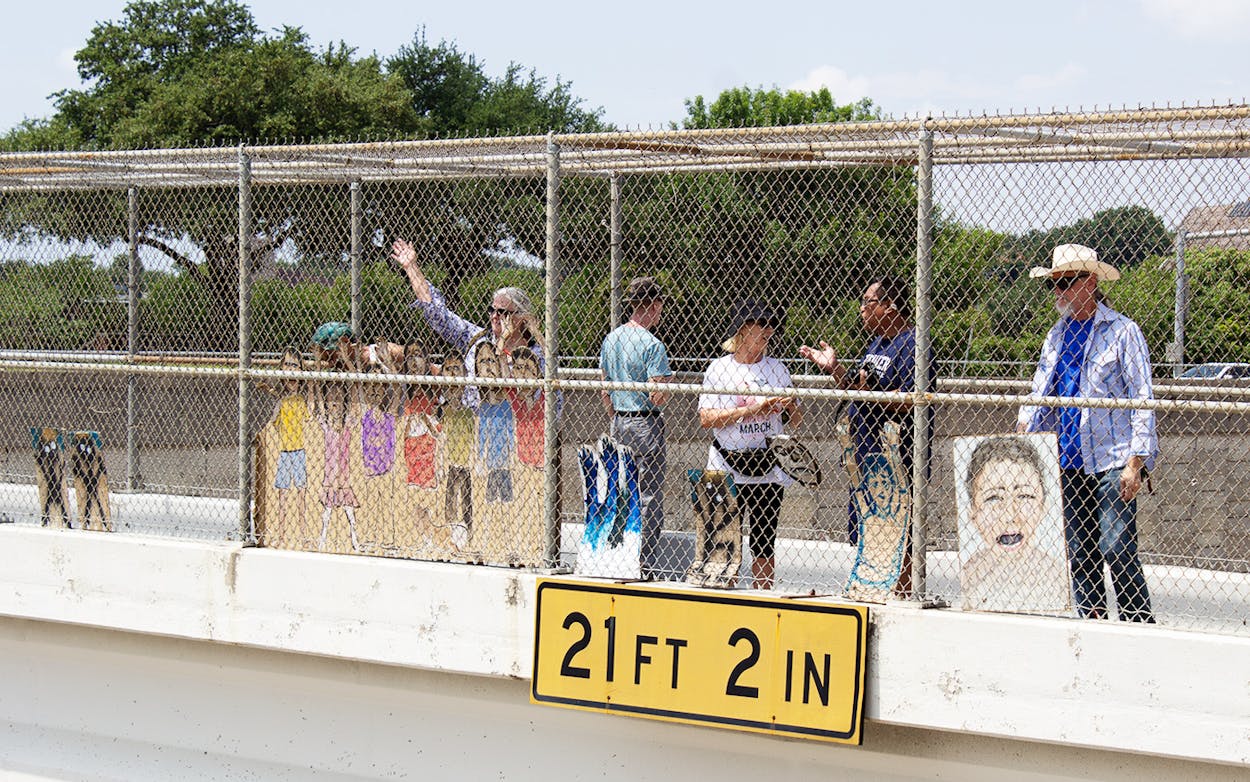If you drove along I-30 last month, you might have noticed something startling over the footbridge near Hulen Street, in west Fort Worth: a group of shadowy figures pressed up against the fence. They weren’t humans, but rather cardboard cutouts emblazoned with paintings of children—and they startled highway drivers. “One of my kids thought they were real for a second,” wrote Ben Maples on Facebook. He was one of many people chattering about the jarring display on social media and wondering how they’d ended up there.
This past Independence Day, the Fort Worth-based artist and curator Linda Little watched the fireworks from that very walkway above I-30, near Arlington Heights High School. The footbridge’s railings and ceiling, forged out of chain-link fencing, reminded her of a cage. Little’s mind then turned toward children in ICE detention centers, and how they “are being incarcerated in inhumane conditions without their parents,” she says.
Two days later, a newly galvanized Little returned to the footbridge with several life-size, highly detailed cardboard cutouts. The children’s faces reflected sadness, despair, and agony; they had their arms raised as if signaling for help. Suddenly, the cutouts had an eerie resemblance to the children being held at ICE detention centers.
From inside the footbridge, the cutouts—attached to the fence with plastic twist ties—don’t necessarily register as a public art installation. But if you see them from the streets on either side of the footbridge, as well as the highway below it, Little’s work quickly becomes profound and eerie—and it’s hard to miss the point.
Little recently joined Patriots for the Children, an activist group that for more than a year has been protesting the federal policy of separating migrant children from their families. Most people carry signs to the weekly protests on University Drive, but Little brings a large painting of a crying boy. “This has been going on for a long time,” Little says. “It’s not a political statement I’m making. I just want the plight of these children to stay at the forefront of our minds. It’s easy to get distracted.”
Throughout July, she continued making trips to the footbridge, gradually adding more cardboard cutout figures to the installation each time. It remained on view for more than two weeks. But after images of the cutouts started circulating on Twitter and Facebook, someone removed the entire piece the afternoon of July 23.
Within 24 hours, other local artists replaced Little’s protest art with their own cardboard cutouts of children, and added neon-colored signs bearing words of encouragement. Little was completely undeterred by the fact that someone had taken the initial cardboard cutouts down—in fact, she’d already decided to keep the project alive indefinitely.

She also started to bring the Fort Worth community into her project. Two days after her original cardboard cutouts disappeared, Little hosted a workshop at the Grackle Art Gallery, the nonprofit space that’s geared toward amplifying local artists, and where she is codirector and curator. Working with other artists from the community, including Kävin Allenson and Joe LaBerge, Little recreated the installation and made it even larger. They added signs, as well as disturbing paintings of children depicted as stick figures, and entire family portraits. This time they also included an unblinking eye, a nod to how the world is watching.
“It’s about human decency, compassion, and understanding,” says Matthew Sacks, who owns Grackle. “But as a work of art, it makes people think and be consciously aware. That’s important.”
The artists put up their new pieces along the footbridge, but they were taken down within a day. It’s unclear who’s responsible for removing the pieces again and again, especially given that no one has contacted Linda or the gallery about it. Still, Little keeps going, recreating the cardboard figures, making them bigger every time, with increasing support from fellow artists, activists, and others who have seen them making the rounds on social media. Supporters have since contributed supplies, created their own artwork to live alongside Little’s, helped attach the pieces to the chain-link fence, or simply showed up in solidarity.
”I saw the picture on Facebook and thought it was so cool,” says Cindy Fountain, a fellow member of Patriots for the Children, who notes that while she’s “not really an artist,” she felt compelled to come and to send information about the project to more people in the community.
Earlier this month, Little met with more than twenty supporters on the footbridge to protest the separation of migrant families and the unhealthy conditions the children are forced to endure. It was a scorching day—90 degrees, and even hotter inside the bridge. The group brought gallons of water to endure the summer heat, and the constant traffic below was so loud that they had to yell at each other to communicate. That day, they also recreated Little’s installation—now for the sixth time—and added signs that said “Honk if you love children” and “No más.” Passing semitrailer trucks seemed to shake the bridge. Many drivers honked their horns, though it wasn’t clear whether they were signaling approval or disgust.
Little is committed to holding workshops at Grackle Art Gallery to keep the project going, as it continues to swell in size and significance and evolves into a community-wide collaboration. “My philosophy is if somebody pushes, you push back harder,” Little says. “This is something I believe in, and these policies are horrific.”
- More About:
- Art
- Fort Worth






